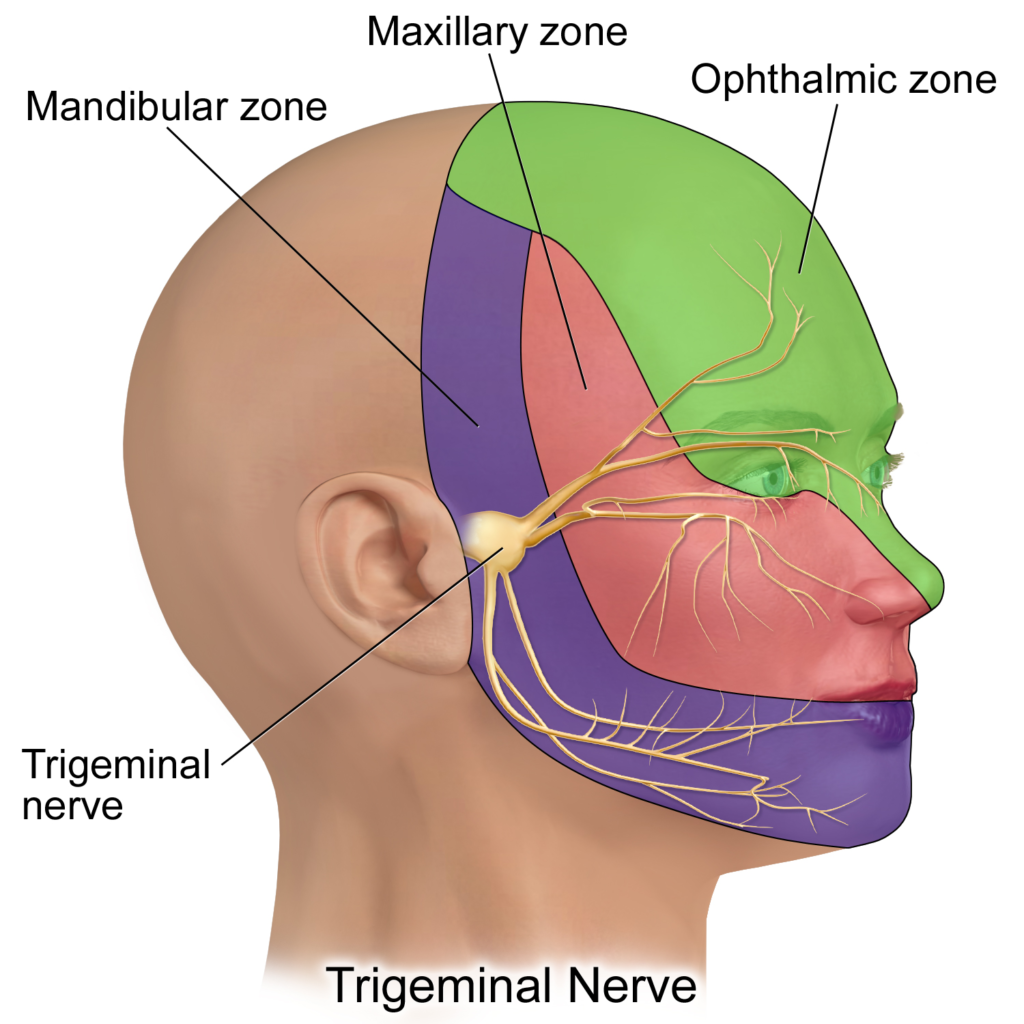What are Trigeminal neuralgia symptoms?
To understand what are the symptoms of Trigeminal neuralgia, first let’s get a little background to make our understanding easier.
Trigeminal Neuralgia is also called Tic Doloreaux. It is described as the most excruciating pain known to humanity. Because of the severity of the pain, and inability to carry out normal daily activities, it can drive patients to suicidal thoughts. This is why it is also sometimes also known as the ‘suicide disease’.

By BruceBlaus – Own work, CC BY-SA 4.0, Link
The Trigeminal nerve is the fifth of twelve pairs of nerves that originate in the brain. That means that there are two trigeminal nerves, each supplying one half of the face. It is responsible for the sensation on the face. Each trigeminal nerve has three divisions V1, V2, and V3. V1 provides sensation in the area of the forehead, upper eyelid, the eye and around the eye. V2 provides sensation to the lower eyelid, upper cheek, side of the nose, nostril, upper lip and upper gum. V3 provides sensation to the lower part of the cheek, lower jaw, lower lip, and lower gum.
Though this disease can affect people of different ages, it is most common after the age of 50 and occurs more frequently in women.
Trigeminal neuralgia is usually caused by one or more blood vessels compressing on the trigeminal nerve. A diagnosis is usually made based on the description of pain and an MRI.
Onset of Trigeminal Neuralgia:
The symptoms of Trigeminal neuralgia are therefore pain in any part of the face usually on one side. The pain seems to begin spontaneously and unprovoked. Occasionally, certain patients complain that their pain begins after an accident which involved the face or after dental surgery. It is possible that in the latter group, the accident or surgery may be coincidental.
What are Type 1 (classical) and Type 2(atypical) Trigeminal neuralgia?
Trigeminal Neuralgia may be classified as ‘Classical (Type 1/Typical)’ or ‘Atypical (Type 2).
With type 1 or classical Trigeminal Neuralgia, the pain is along the distribution of one or more of the divisions of the trigeminal nerve. The pain is intense, sharp, or shock-like, and has trigger factors. There are also definite periods when the pain disappears completely (remission). This is how a typical attack looks like.
type 2 or atypical Trigeminal Neuralgia pain is generally a constant, burning type and affects a wider area of the face not along any particular division. It is unlikely to have any remissions, and are more difficult to treat.
Classical Trigeminal Neuralgia:
- Begins spontaneously, and over a period of time, patients notice trigger factors.
- The pain episodes tends to be cyclical. Patients may experience these attacks quite frequently for a few weeks followed by many weeks or months of little or no pain. As the disease progresses, the pain attacks tend to become more intense with increasing duration and smaller pain-free intervals. Some patients can have just one attack over a few days, whereas others may experience multiple attacks every hour. The pain typically lasts less than 15 seconds, but may extend to a few minutes.
- Occasionally, in V1 type of Trigeminal Neuralgia, there may be pain within the eye and redness &/or tearing.
- It is quite common for people with V2 or V3 type of Trigeminal Neuralgia to have dental procedures (teeth extraction, root canal) done in the belief that bad teeth may be the cause of pain.
- In most patients, for the initial few months/years, pain attacks brought on by trigger factors make it more predictable.
- However, in a small set of patients who go untreated, the pain loses its predictability. The pain episodes may occur at any time, without any warning in spite of avoiding all trigger factors. This makes the patients live in constant dread of a pain attack appearing. They tend to withdraw socially and begin to have personality changes, depression, and suicidal thoughts.
Atypical Trigeminal Neuralgia:
This is also a type of Trigeminal neuralgia but tends to be more continuous kind of pain; it is generally not a sharp kind of pain.
Are there other kinds of Facial pain?
Yes, they could be Trigeminal neuropathic pain, deafferentation pain, post-herpetic trigeminal neuralgia, or TN caused by Multiple sclerosis.
Does Trigeminal Neuralgia get worse at night?
Not necessarily, but if it does, it could be because of the following reasons:
- Temperature is cooler at night (trigger)
- no distractions
- Changing postures during sleep may activate trigger zones